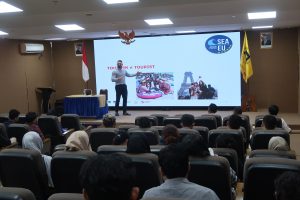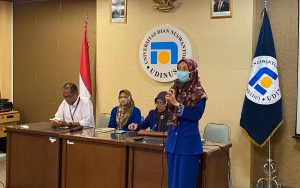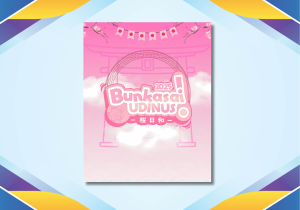The Humanities Faculty at Universitas Dian Nuswantoro (Udinus) partnered with the Computer Science Faculty to develop educational media in the form of Virtual Reality (VR) and Augmented Reality (AR). The project was funded by the Kedaireka Funding Program, which specifically aimed at the Borobudur Temple.
The media will later come in two languages, namely, Indonesian and English. This will allow foreign tourists as well as local tourists to understand it.
The project involves six faculty members from the English Department who will develop the bilingual content, including Dr. Dra. Sri Mulatsih, M.Pd., Dr. Raden Arief Nugroho, M.Hum., Valentina Widya Suryaningtyas, M.Hum. As for the storytelling department, it will be handled by Drs. A. Soerjawardhana, M.pd., a Hotel Management lecturer.
Meanwhile, the AR and VR outputs will be handled by two lecturers of Visual Communication Design at Udinus, namely, Ali Muqoddas, S.Sn., M.Kom., and Erika Devi Udayanti, S.Kom., M.Cs. The collaboration between the Humanities and Computer Science Faculties aimed to produce a bilingual learning medium based on Information Technology.
The leader of this project, Dr. Dra. Sri Mulatsih, M.Pd., stated that the innovation was a response to the rise of entry prices to the Borobudur Temple, which has currently reached its viral point. In addition, the fact that learning media for the Borobudur Temple was pretty much minimal within the temple’s area also inspired the team to come up with VR and AR innovations.
“We developed the innovation in the form of a learning medium to describe history and other aspects of the temple. We decided to make our outputs based on technology as it would attract students to learn through technology,” she uttered.
The VR media will allow visitors to conduct a virtual tour of the temple without having to climb into the temple area. As for the AR media, visitors can learn the history and physical characteristics of the Borobudur Temple by accessing the app using an augmented chip on smartphones.
“We will also continue developing the 3D Digital Boxes, which will be installed in various spots within the temple. The 3D Digital Boxes will also be equipped with bilingual storytelling, with students and foreign tourists being the main targets,” Sri Mulatsih added.
The innovation passed the selection process and will be funded Rp. 500 million from the Kedaireka Funding Program, with the proposal being titled ‘The Education Model Development of The Borobudur Cultural Heritage Using Interactive Animated Bilingual Storytelling Based on Multimodality. The project outputs are scheduled to be launched in December.
Dr. Raden Arief Nugroho, M.Hum., the Dean of the Humanities Faculty and one of the team members, hoped for this innovation to attract the public to visit the Borobudur Temple. Moreover, he also suggested for the Digital Boxes to be placed in various inns, hotels, or schools. The dean further hoped for other innovative research to be conducted by lecturers at Udinus.
“This type of research is very important for the campus accreditation and the faculty itself. Hopefully, this research can motivate our fellow academicians to pursue the same goal,” the dean concluded. (Humas Udinus/Haris. Foto: Dok. FIB)






